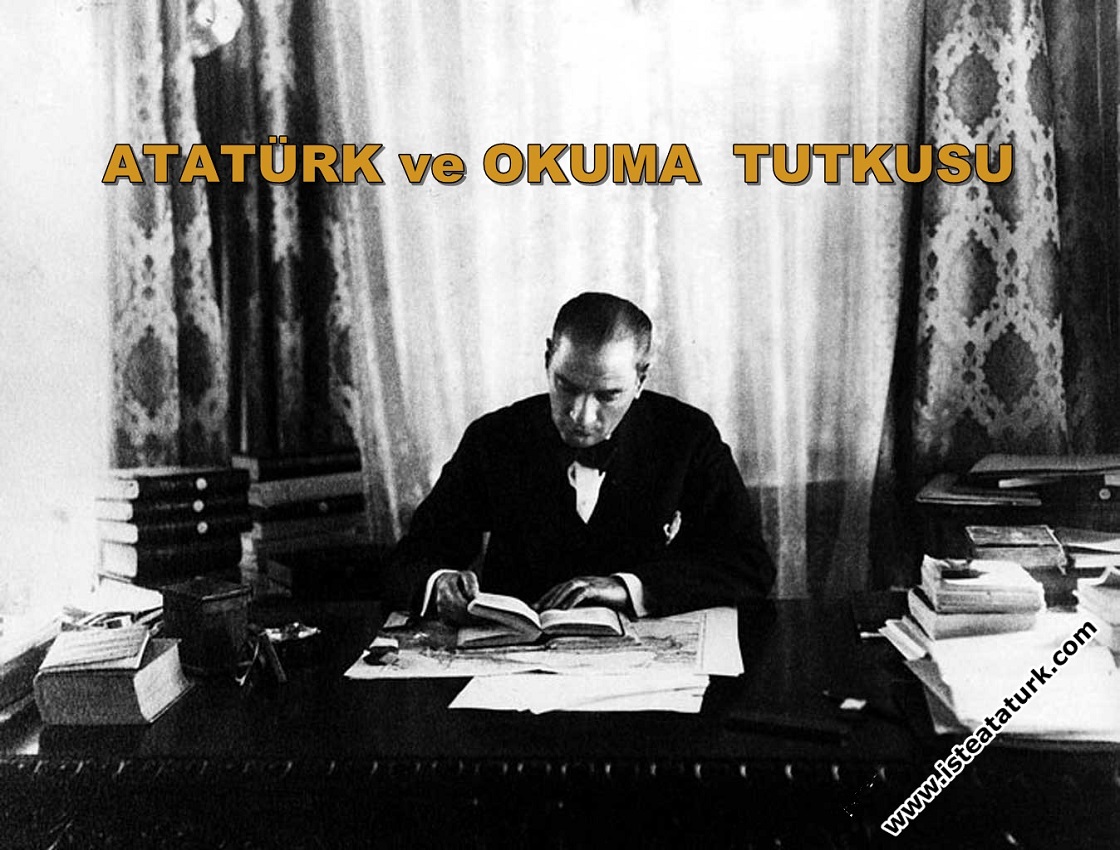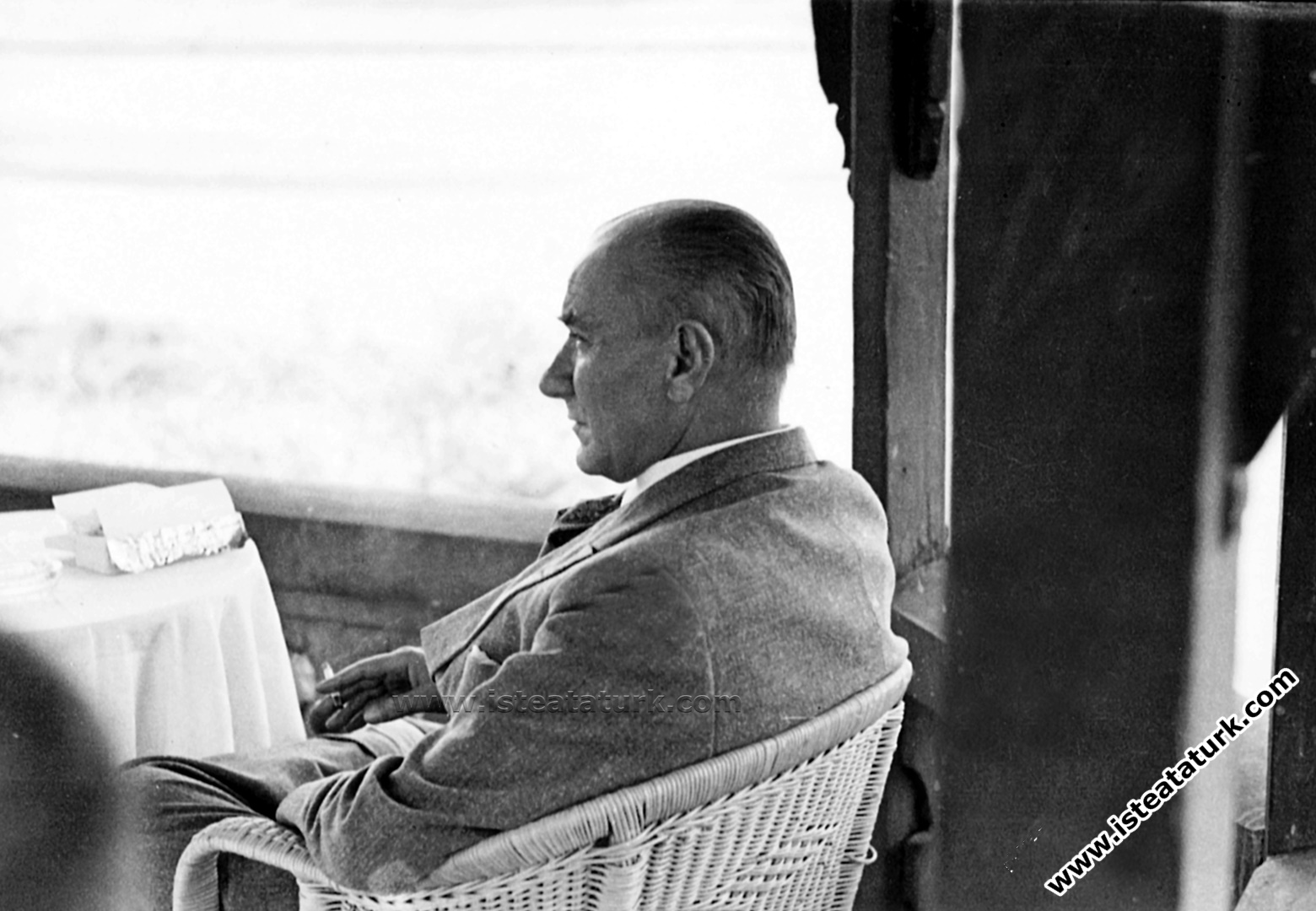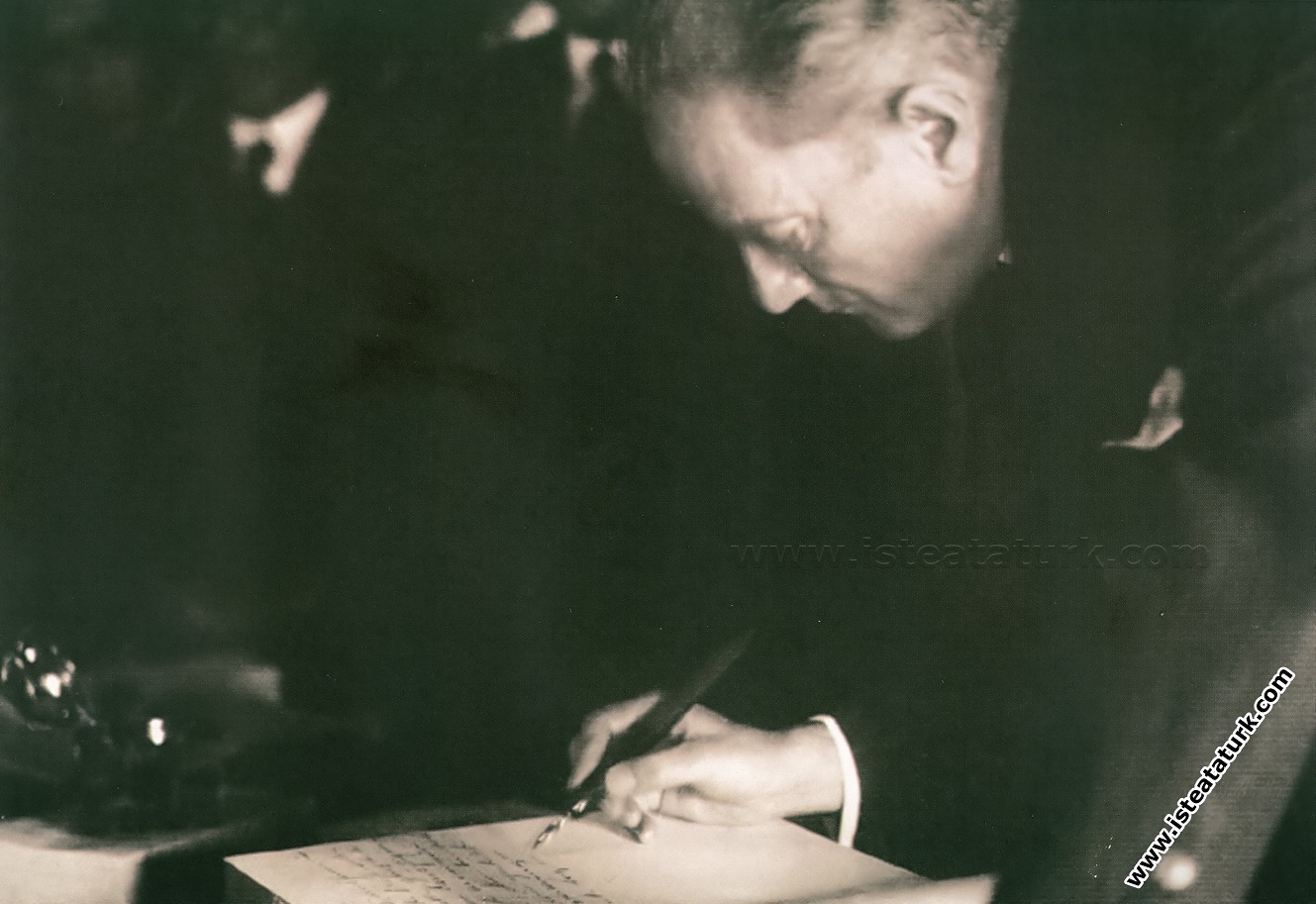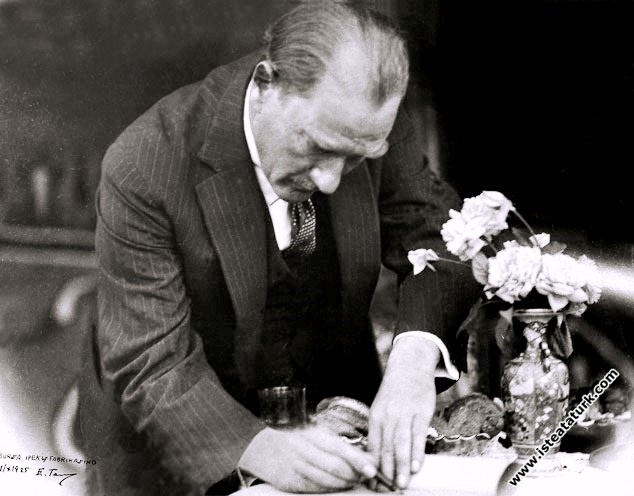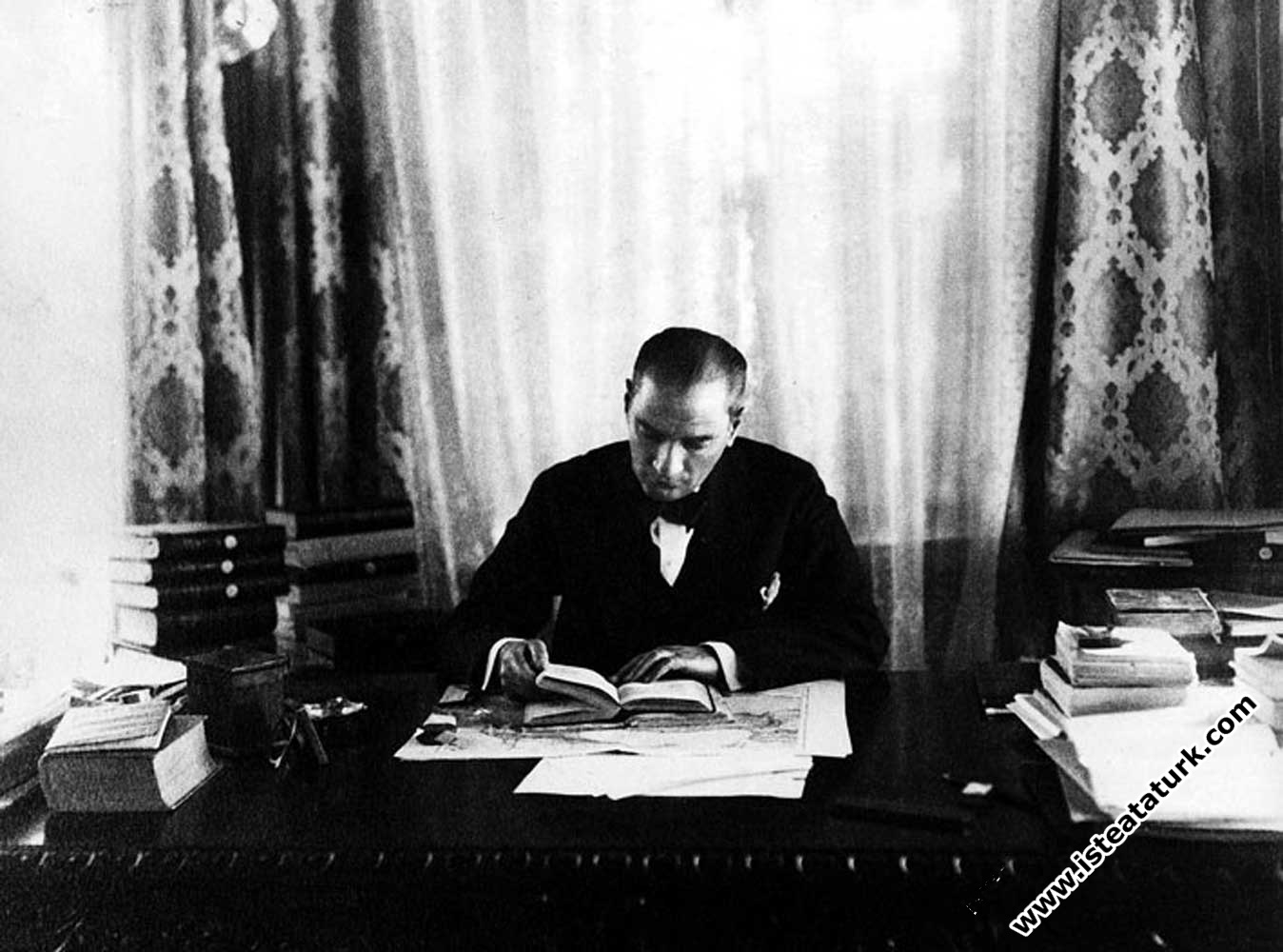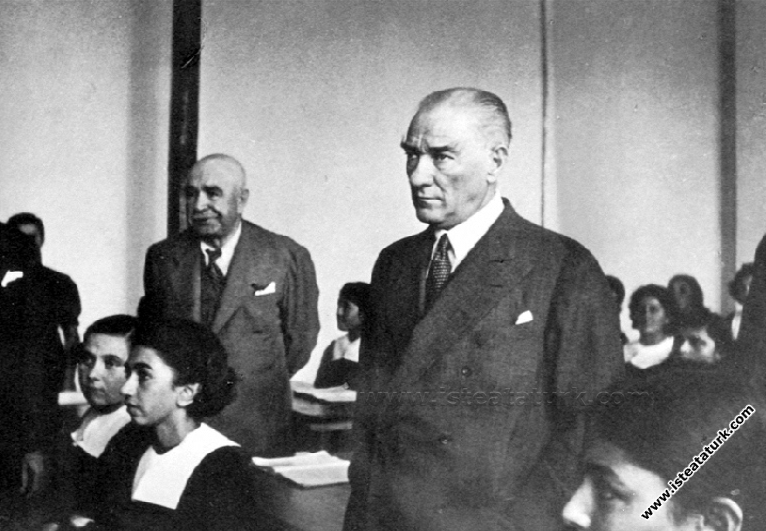
Atatürk and History Awareness
Character Size
Atatürk and History Awareness
ATATÜRK and HISTORY AWARENESS
By 1923; As a result of long struggles, the invading forces were expelled from the country, but the real struggle had just begun, as Mustafa Kemal Atatürk put it. This struggle was not only a struggle for the development of a country devastated by years of war, but also a struggle to redefine the nation, to give it self-confidence, national consciousness, a new understanding and love for the homeland.1 In other words, it was a struggle for culture.2
In this struggle, Atatürk will especially benefit from history, and after the establishment of the Republic, he will increasingly devote most of his time to studies related to the science of history. Because history is one of the most important creators of the common national culture.3 We know that Mustafa Kemal was interested in history since his youth, and that most of the books he read were history books. As a matter of fact, when the Istanbul University Faculty of Letters decided to give him the title of Honorary Professor (mudarris) in 1923, he welcomed this and told the delegation that he had been busy with history since his school days, and therefore the Honorary Professorship should belong to history. Again, due to this title being given, "I am sure that your faculty will continue our national independence in the field of science,"
It should be noted that this love of history and knowledge of history were very beneficial for him both in terms of getting to know his nation and what his nation could do, and in terms of the eloquence in his oratory. For this reason, we can say that “If one of the most powerful weapons Atatürk benefited from was his intelligence and genius, the second one was knowledge of history.”5 Because, “History science, with its unique methods, will determine the foundations on which the cultural institutions that a nation will create and establish in the future and how it will be built on them. It prepares feasibility reports by conducting cultural research in the depths of the cultural ground that a direction needs to be given... It is not possible to make new additions or establish a cultural framework without examining the cultural ground of a nation. A tight bond to be established between History and Culture; a man and a society from the bondage of other nations,
On the other hand, the understanding of Ottoman historiography was mostly dynastic. Due to the social and administrative structure of the state, there was no mention of Turkishness, the Turkish Nation, even the contributions of Turks to the Islamic Civilization and the services they rendered to Islam. After the Tanzimat, the Turks were almost left out of sight in the ideal of Ottomanism, which meant the effort to keep all Muslim-Christian Ottoman subjects together in equality of rights, in which various groups embraced like saviors in order to save the state from disintegrating against internal and external threats. The mission of Tanzimat historiography was to create an "Ottoman Nation" and an "Ottoman History Consciousness". For this reason, in the historiography of the Tanzimat period, it was discussed that a state was created out of a tribe. The nation that created this world state and the rich history behind it, it was assumed that culture and civilization did not exist at all; As we will indicate later, Atatürk will demand that the subject be investigated scientifically, stating that the tribe cannot become a world state.7 Of course, these deficiencies in our historiography will cause delay in the awakening of national consciousness and nationalism. However, national consciousness and a sense of nationalism were awakened in Europe long before the years corresponding to the Tanzimat. With this awakening, progress in science and technology, industrialization, democratization in political life, and the participation of the people in political life increasingly dominated the social life. .
The developments after the Tanzimat are well known to everyone. Neither the Ottoman ideal nor the Ottoman Historiography could create a common Ottoman Consciousness. On the contrary, the European States, which made continuous progress in science, technique, political and social structure, in short, in civilization, took the Ottoman Empire into a network of exploitation that was getting more and more heavy, and the efforts to get rid of this network were insufficient, unsystematic, and most importantly, when it was late, the Ottoman Empire could not be saved and became a thing of the past. . After the Ottoman Empire, which held the economic, political and most strategic regions of the world, we were able to hold on to the present humble lands at the expense of spending all the remaining energy and power to the last point.
The foundation of the new “Turkish Republic”, the national state that was established now and that has chosen to rise above the level of contemporary civilizations, is Turkish culture. In other words, the new Republic of Turkey was a state founded on the basis of the unity of culture, language and history on a part of the homeland with certain borders, not on the basis of race, and the definition of the new nation was therefore made as "How happy is the one who says I am a Turk" rather than "How happy is the Turkish one". In that case, self-confidence, the happiness and joy of being Turkish, and national consciousness should be given to this cherished nation, which has been systematically humiliated for centuries and spent its last years in great pain. On the other hand, the political and social structure will be changed in the most appropriate way to the national structure and will be put on the path of modernization. A people who have been argued by Europeans for years as one of the future dangers of the Turkish Nation, that the Turks are a second class nation from the yellow race, deprived of all kinds of civil abilities and aptitude, semi-wild, barbaric, belligerent, destructive, and never grow grass wherever they pass. We understand that he has seen the theses that he is. He had a desire to refute these theses in his heart as a pain. Because the same Europeans, based on these baseless claims, will make propaganda that the Turks should be expelled from Europe and Anatolia, and they will cause so many disasters. He had a desire to refute these theses in his heart as a pain. Because the same Europeans, based on these baseless claims, will make propaganda that the Turks should be expelled from Europe and Anatolia, and they will cause so many disasters. He had a desire to refute these theses in his heart as a pain. Because the same Europeans, based on these baseless claims, will make propaganda that the Turks should be expelled from Europe and Anatolia, and they will cause so many disasters.
It is from this perspective that Atatürk's theses on Turkish History and Turkish Language, which his scientific validity was left to the researches of those dealing with the science of history, should be evaluated. Because he wanted to explain that Anatolia is the homeland of the Turks, and that it will forever be the homeland of the Turks, against these ruthless nonsense put forward by politicians and scientists who can be considered serious in Europe.
For all these reasons, Atatürk's works until 1928 continued in a more systematic way after 1928. This year, all history books, including those taught in schools and those written in a foreign language, were collected and examined, and a library was established. Meanwhile, the best books on law, sociology, economics, but especially history were brought from abroad. On September 12, 1929, Paris Ambassador Fethi Okyar was asked for the most comprehensive and high "General History" book with the books of the courses taught in French Law Faculties, and a month later, books containing the latest research on the origin and civilization of the Sumerians were requested. On November 2, 1929, Ernest Lavisse's 12-volume History of Civilization, Alfred Rambaud's “Historie Generale des Peuples et des Civilisations” (General History of Civilizations and Peoples) is requested. In 1931, four volumes of Rene Grousset's History of the Far East, The Awakening of Asia, British Imperialism and the Revolt of the Peoples and the four-volume book Eastern Civilizations, which were published in these years, were brought. In 1935, these orders continued and many books were brought in the fields of General History, History of Political Institutions, History of New and Modern Ages, History of Economics, History of Religions, History of Diplomacy, History of Philosophy, History of Sciences, History of Art, as well as Statistics, Economics and Sociology books. we see.10
In 1930, the Turkish Hearths, which had close relations with the state and the government until then, VI. The convention convenes. In the congress, with the proposal of Sadri Maksudi Arsal and the support of Afet Inan, a History Committee is established alongside the Science and Art Committee.11 The task of this committee is to “Study and Test Turkish History and Civilization in a Scientific Way”. 12 Some of the members of this committee (Afet Hanım, Mehmet Tevfik, Hasan Cemil, Sadri Maksudi, Şemşeddin, Vasıf and Yusuf Ziya Bey) were reminded of the work titled “The Main Lines of Turkish History” with Atatürk's directives, and it was not liked by Atatürk because of its many deficiencies and mistakes. and it was not published, except for the copies made to be presented to the views of scholars.13 Because, in Atatürk's words, “History cannot be a product of imagination, we should try to use real events when writing history.
However, studies on the main idea, the place and contributions of Turks, who are an honorable and great nation, in the family of world civilizations, were continued in a more systematic way while preparing the work titled Main Lines of Turkish History. While this book was being prepared, many people were asked to comment and contribute to the idea that was intended to be given, necessary corrections and additions were made to the distributed copies, and even Atatürk himself made these corrections and additions.15 The questions that Atatürk wanted to be answered in terms of Turkish History were: What kind of world state did they create from the tribe? Should there be another explanation for this? The science of history must reveal this. What does the Turks have to do with the lived and extinct civilization of the Mediterranean? What is the role of the Turks in world history and civilization?16 After the corrections and additions mentioned above, Atatürk will demand that a new four-volume history book be prepared to be taught in schools.17
After all these preliminary studies, after the closure of the Turkish Hearths, the Turkish Historical Research Society was turned into an independent institution on April 15, 1931, and important tasks were given to this society, which would later become the Turkish Historical Society in 1935. As a matter of fact, the first History Congress in 1932 and the second in 1937 were organized by this society and institution. Before starting the congress activities, where local and foreign scientists were also invited, Atatürk addressed the members as follows. “Our nation has a deep past. Of course, this thought brings us from the six or seven centuries of Ottoman Turkishness to the Seljuk Turks and to the Turkish States, which were equal to each of these eras before that. Our ancestors, who founded great states, had a great and comprehensive civilization. It is our duty to seek, investigate, and inform the Turks and the world.18
The idea of carrying out all these studies with an academic spirit and understanding on the one hand and transferring them to new generations on the other was put forward in 1933, and as a result of the studies that started in 1935, the Faculty of Language, History and Geography was opened in 1936. Initially, the Faculty was thought to be the Faculty of History-Geography, but Language was added so that it could be researched in all languages that could be a source for Turkish History.19
We see that since 1934, Atatürk gave information to the parliament and the public about these studies, which he expressed as “establishing Turkish History on the right foundations”20 in his speeches at the opening of the parliament. For example, on November 1, 1936, the 5th term of the parliament II. In his speech at the opening of the meeting year, he said, “...I would like to commemorate with appreciation the serious and continuous work of the Turkish Historical Society and the Turkish Language Society, led by our esteemed deputy of education, which opened new horizons of truth today. As long as these two national institutions reveal the forgotten depths of our history and language, their maternity in world culture, with irrefutable scientific documents, I can say with utmost importance that they are performing a sacred duty that attracts attention and intimacy not only for the Turkish Nation, but also for the entire scientific world.” He said 21.
In the opening speech of the parliament in 1937, Atatürk; He was giving the following directives by expressing that in order to understand, explain and transfer the country's cause from generation to generation, it is necessary to consider the country as three great cultural regions, provided that for now. “It is necessary to implement the reform program that started at Istanbul University for the western region in a more radical manner, to bring a seriously modern university to the republic, and to establish Ankara University for the central region in a short time. For the eastern region, action should be taken to create a modern cultural city with its primary schools and finally its university in the most beautiful place on the shores of Lake Van.”22 Because, according to him, “...our great cause is to increase our existence as the most civilized and prosperous nation. .”23
In conclusion, we would like to express the following: Mustafa Kemal Atatürk relied on the values of his nation both in the National Struggle and in the new struggle he entered with a different political and social organization after 1923. He had now set his nation to “reach the level of contemporary civilizations, even surpassing them” as a goal. Considering 1923 and beyond, this goal might sound like a fantasy to a foreigner. But for Atatürk, the guarantee of this is Turkish History and Culture. According to him, the Turkish nation is intelligent, hardworking, and as they get to know their ancestors, they will find enough strength to do greater things. Again, he wanted to equip the Turkish nation with a new consciousness and a new spirit in order to reach this goal. Being an honorable member of the human family, the Turk had many more contributions to make in the name of civilization. This contribution, as he stated in a speech he made in March 1923, would be thanks to our intellectuals getting to know their own nation and walking hand in hand with it. Atatürk expressed this in Konya on March 20, 1923:
“... In general, we have the following error that we should take our own country, our traditions, our own specialties and needs as a basis for our study and correspondence. Our intellectuals may know the whole world, all other nations, but we do not know ourselves. Our intellectuals say, "Let me make my nation the happiest nation". He says, "Let me do it exactly as other nations have done." However, we must consider that such a theory has never been successful in any era. What is bliss for one nation can be a disaster for another. The same reason and circumstance can make one happy, but make the other miserable. That's why, while showing this nation the way to go, let's make use of the world's discovery and progress from all kinds of science, but let's not forget that we have to extract the real foundation from ourselves, the history of our nation,
Organized at Sivas Cumhuriyet University on 29.5.1996, the “21. It was presented as a paper in the panel titled “Atatürk's Views as We Enter the 21st Century”.
1 Kemal Karpat, “Turks”, Encyclopedia of Islam, Vol. XII., 1st. 1988, p. 392-394.
2 “Atatürk's works in the field of history are the continuation of the War of Independence in the field of culture”, Enver Ziya Karal, Atatürk and the Revolution, Conference and Articles, Ankara 1980, p. 95.
3 Turhan Feyzioğlu, “Atatürk and History”, Atatürk Week Gift, General Staff ATEŞE spring., Ank. 1986, p. 6.
4 Mehmet Saray, “Atatürk and Turkish History”, Turkish Culture, Year XXII, January 1984, Issue 249, p. 3.; Cengiz Orhonlu, “Atatürk and History”, Turkish Culture, Year VI, November 1967, Issue 61, p. 27.; Şemsettin Günaltay, “A Memoir About Atatürk's Historiography and His Professorship of History”, Belleten, C. III, Issue 10 (1939), p. 273-274.
5 Bayram Kodaman, “Atatürk and History”, Atatürk and Culture, Ankara 1982, p. 5.
6 Bayram Kodaman, “The Place of Culture in the Atatürkist Thought and Development Model”, Atatürk Culture and Education Seminar, Kayseri 1982, p. 68-69.
7 Feyzioğlu, supra, p. 7-8; Big, Ataturk and History, p. 4-5.
8 Hilmi Ziya Ülken, Nation and History Awareness, 1st. 1948, p. 169.
9 Feyzioğlu, supra, p. 6.
10 Bilal Şimşir, “Atatürk's Love for Books”, Atatürk Culture and Education Seminar, Kayseri 1982, p. 85-92.; See also Gürbüz Tüfekçi, Atatürk's Books, Ankara 1983.
11 Afet İnan, Memories of Atatürk While Commemorating Kemal Atatürk II, Ankara 1955, p. 81; Adile Ayda, “The Role of Sadri Maksudi in the Establishment of the Turkish Historical Society”, Turkish Culture, P. 53, Year V, March 1967, p. 324-325.
12 Kodaman, “Ataturk and History”, p. 7.
13 İsmail Hakkı Uzunçarşılı, “Memories of Atatürk's Relevance and Views While Written Turkish History”, Belleten, Vol. III, P. 10 (1939), p. 349-350.
14 Bekir Sıtkı Saykal, “The Role of History in Atatürk's Revolutions”, Cultural Revolution under the Leadership of Atatürk, Regional Cooperation for Development (RCD) Seminar Communiqués, Ankara 1972, p. 97.
15 Saray, ibid, p. 8.
16 Orhonlu, agm, p. 28. At this point, Prof. Dr. We owe a debt of appreciation to M. Fuad Köprülü's work.
17 Saray, agm, p. 8.
18 Enver Ziya Karal, Atatürk's Thesis on Turkish History Kemalism, Atatürk and Articles on Kemalism, II. Book, p. 162.
19 Afet Inan, “On Preparations for the Establishment of the Faculty of Language and History”, History Studies, C. I, Ank. 1957, p. 1-16.
20 Atatürk's Speeches and Statements, Vol. I-III, Ank. 1981, p. 377.
21 Discourses and Statements, C. I, p. 387-388.
22 Discourses and Statements, C. I, P. 401-402.
23 ibid, p. 401.
24 Discourses and Statements, C. II, p. 141-142.
Dr. Ayfer Özçelik
Source: ATATÜRK ARAŞTIRMA MERKEZİ DERGİSİ, Sayı 35, Cilt: XII, Temmuz 1996
